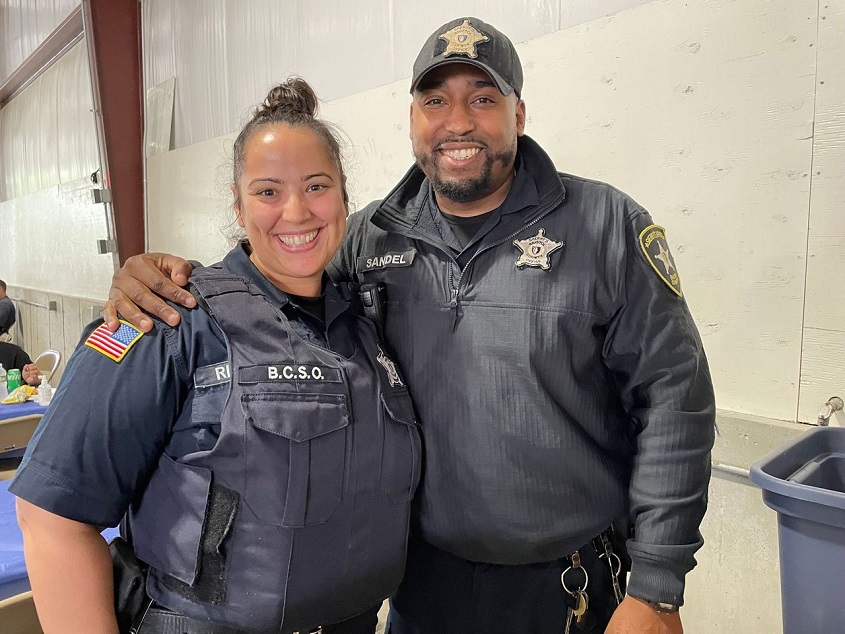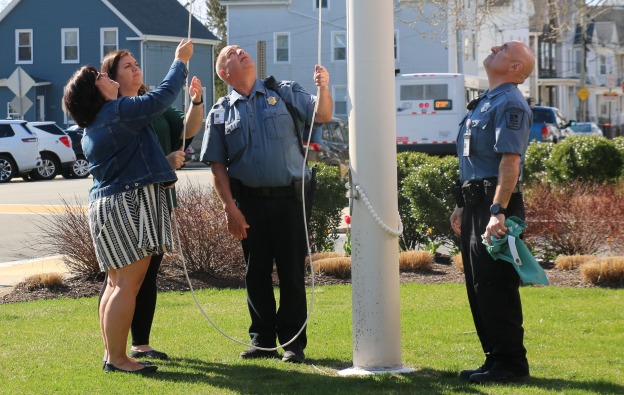Gov. Charlie Baker and Transportation Secretary Stephanie Pollack joined Mayor Jon Mitchell and local officials to celebrate the official opening of the CoveWalk, New Bedford’s newest recreational waterfront path.
Located atop the New Bedford Hurricane Barrier on the west side of the South End peninsula, the 5,500-foot CoveWalk was made possible with $5 million in state grant funding administered by the Massachusetts Department of Transportation. In 2015, New Bedford opened the 3,400-foot HarborWalk on the east side of the peninsula, providing extraordinary views of New Bedford Harbor.
Members of the Baker-Polito administration have visited New Bedford’s waterfront and supported investment in the area. Since taking office in 2012, Mayor Mitchell has called for the reconnection of the waterfront with residential and downtown areas. A key element of the Mayor’s plan was the construction of a path atop the hurricane barrier, which protects the harbor and eastern portion of the city’s peninsula from storm surge. The New Bedford Hurricane Barrier is the largest manmade structure on the east coast of the United States and now features a recreational pathway that offers spectacular water views.
“Reconnecting the City and its neighborhoods to the waterfront is a project that I have felt is extremely important to New Bedford,” said Mayor Mitchell. “With the elevated hurricane barrier between South End neighborhoods and the water, the CoveWalk and HarborWalk once again offer spectacular views of Clark’s Cove and New Bedford Harbor for residents and visitors. It is a unique and beautiful space where you can walk, run, or bike with an extraordinary view.”
“Our administration is proud of its partnership with our Commonwealth’s municipalities and pleased to make investments like these that strengthen opportunities in communities like New Bedford,” said Governor Baker. “This innovative CoveWalk will provide a range of new recreational, transit, economic and tourism benefits for visitors, individuals and families throughout the region.”
“We are dedicated to working closely with cities and towns throughout the Commonwealth to achieve our shared transportation and economic goals,” said Lieutenant Governor Karyn Polito. “By investing in local projects such as New Bedford’s CoveWalk, we can empower our communities and better connect our citizens with opportunities that improve their quality of life.”
“The new CoveWalk will help restore access to New Bedford Harbor and promote increased connectivity and development throughout the region,” said Secretary Pollack. “We are pleased to have supported this project as we continue investing in local infrastructure upgrades that allow people to utilize all modes of transportation including bicycling and walking to reach the places they need to go.”
Construction of the CoveWalk was completed by P.A. Landers and Seguin Enterprises. The CoveWalk is 5,550 feet long, average of 13 inches thick and contains 2,230 cubic yards of concrete. Workers installed 11,100 feet of custom-made aluminum railing, and 44,300 feet of electrical wiring to supply power to the 230 light fixtures that illuminate the pathway after sunset.
The CoveWalk and HarborWalk connect with a bike path that runs along the waterfront to Fort Taber Park, a 50-acre park at the end of the city’s southern peninsula and provides more than a mile of ocean frontage overlooking Buzzards Bay. Both paths are part of The Blue Lane, a recent designation that describes the city’s waterfront paths, spanning the 11-mile shoreline of the city and signasl to residents and tourists a contiguous set of recreational pathways that allow visitors to travel along the entire New Bedford waterfront, connecting the attractions not only to local neighborhoods, but also to one another. The Blue Lane connects several city parks, including Hazelwood and Fort Taber parks and East and West beaches in the South End, with bike paths along JFK Boulevard and Herman Melville Boulevard as part of The Blue Lane linking to Riverside Park, Rivers End Park, and the planned RiverWalk in the North End.
History of the New Bedford Hurricane Barrier
In 1962, construction of the hurricane barrier across New Bedford Harbor began in an effort to greatly minimize the destructive effects of flood waters associated with severe storms. Dedicated in 1966, the hurricane barrier remains the largest manmade structure on the east coast of the United States and provides security for industries, the fishing fleet, and hundreds of homes in residential neighborhoods. The Harbor Barrier and Dike have protected New Bedford and the neighboring communities of Acushnet and Fairhaven from storm surge but, the dike portion of the structure—a massive 18 foot high, 4,600 foot stone wall—has limited public access to the water.
 New Bedford Guide Your Guide to New Bedford and South Coast, MA
New Bedford Guide Your Guide to New Bedford and South Coast, MA








